‘Le Jardin Secret Open Air Museum’ in Marrakech’s massive medina is the restored riad of the last sultan of Morocco. It has two courtyards; the larger is the Islamic Garden, a paradise garden in reinstated cruciform layout and replanted in keeping with the tradition of Islamic gardens. The other is the Exotic Garden – more intimate with complex planting. This smaller one fired my imagination, so I’ll write about it here.
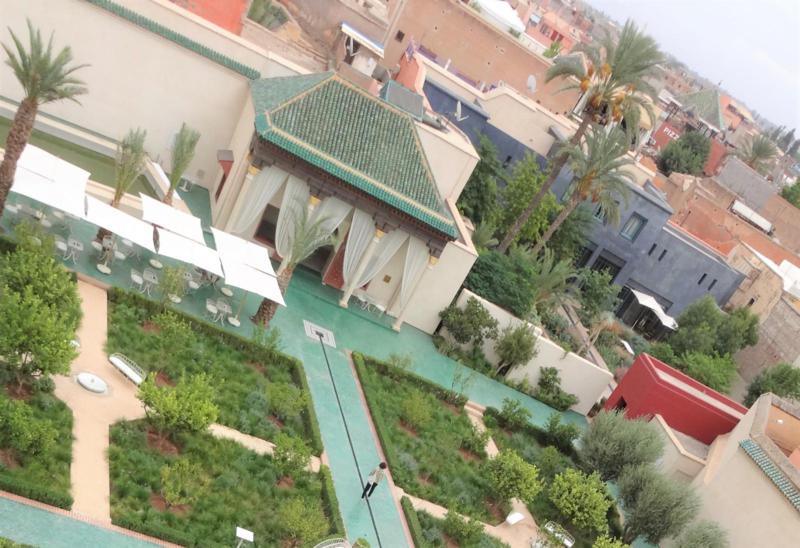
Taken from up the tower, looking across the Islamic Garden towards the Exotic Garden which is beyond the red coloured pavilion. It is a haven from the hustle and bustle of the souks and their labyrinth of laneways.
I adored this garden. Designed by Tom Stuart-Smith from the UK, it is gobsmacking from every angle – visually thrilling plant scenes with layers and layers of texture, colour and form, all within a walled courtyard and a stylish entrance building.
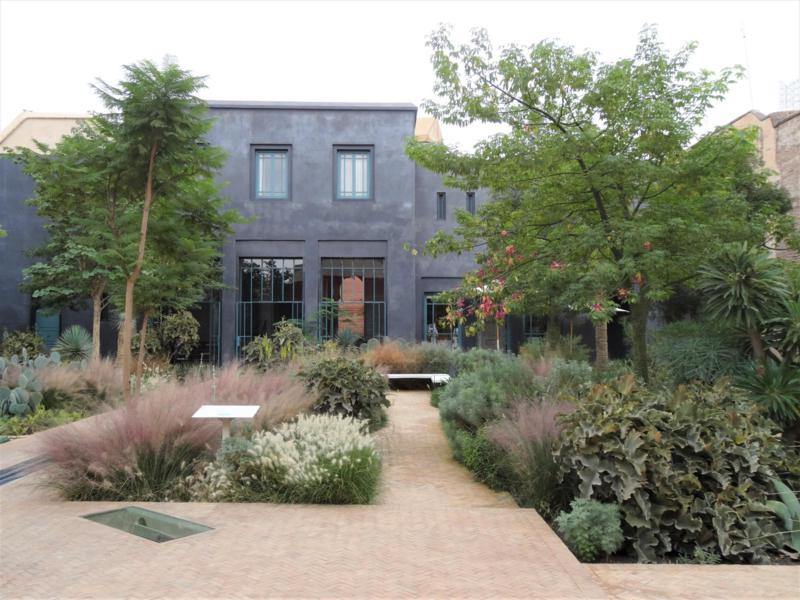
In the Exotic Garden looking towards the entrance building.
The central axis spans from the entrance to the pavilion opposite. A rill extends along this raised axis, set in a path of earthen pavers (bejmat) in a herringbone pattern. The paths continue around the garden in a geometric layout, allowing easy access through and around the garden. The subtle patina of the unglazed bejmat is very satisfying alongside the grey-greens and blue-greys of the plants.

The pond, water bowl and rill on the central axis. Waterways, above and below the ground, use gravity to distribute the water throughout the complex.
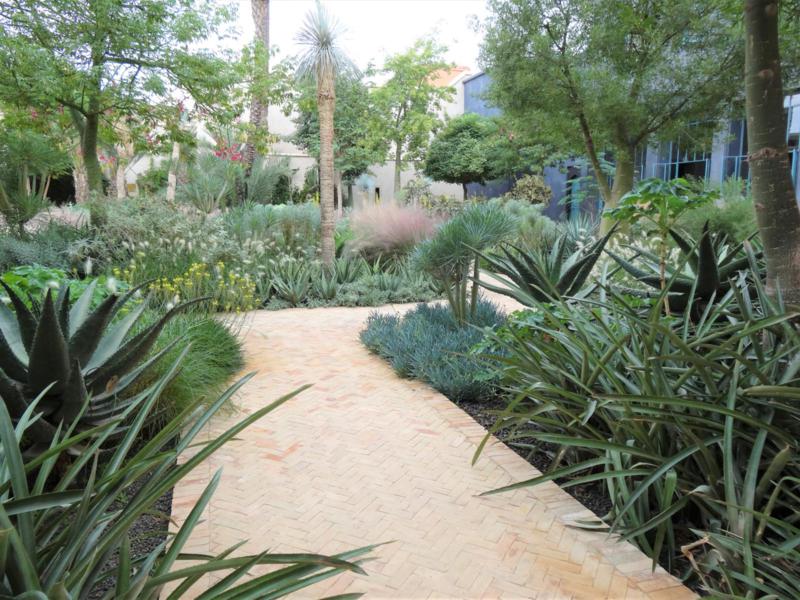
Paths of unglazed bejmat in herringbone pattern, a comfortable width for ambling.
Sitting areas with the same paving are fitted with corner benches, their location and multi-direction ideal for taking in the full breadth of the glorious plant scenes. The benches are cushioned (thank you), with metal frames that form a link with the casement window frames of the entrance building.
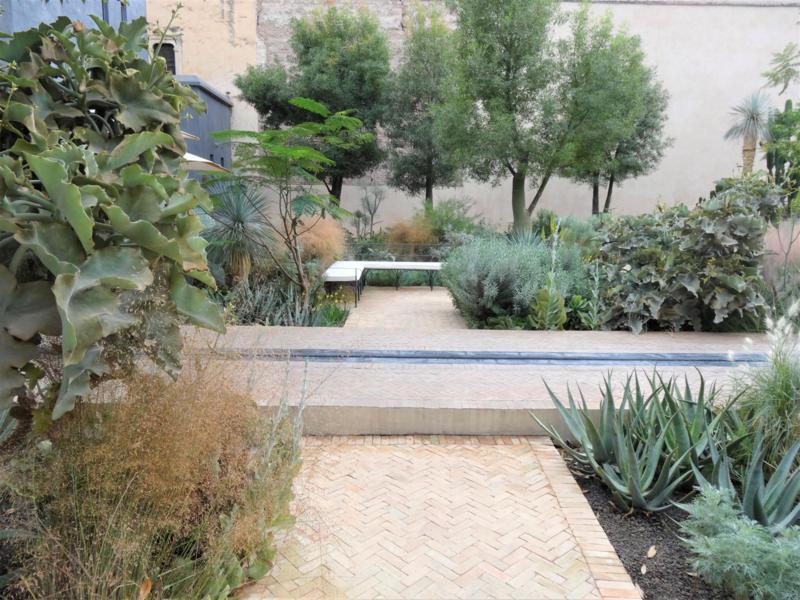
Path crossing the central axis to the bench by the bottle trees.
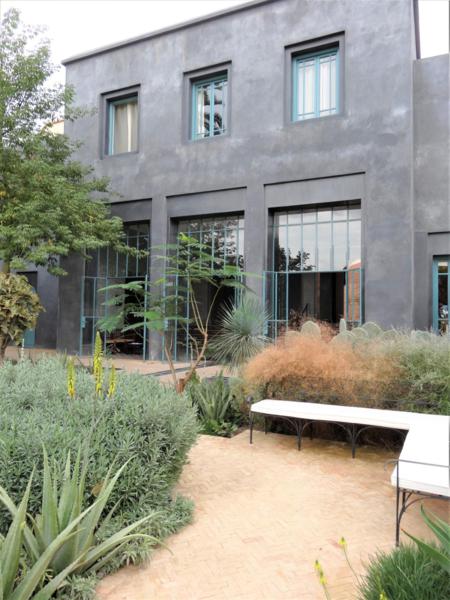
Cushioned bench with the entrance building as backdrop, its window frames harmonising with the plant foliage colours.
The garden walls are a pale earthen shade, a backdrop that highlights the plant spectacle, and tones with the pavers. Other wall colours are bolder – the entrance building a moody charcoal, and the pavilion that connects this garden with the Islamic garden is a dramatic deep-red ochre. This confident colour is prominent, contrasting with the cool silvers and greys but not overly so, and the boldness-with-restraint creates an extremely pleasing overall image.
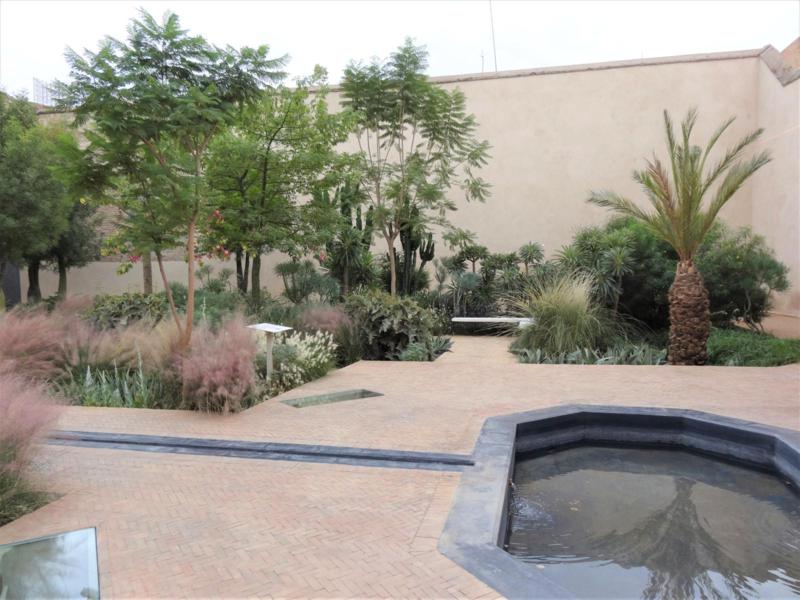
High garden walls finished with tadelakt plaster – a perfect garden backdrop.

The modern pavilion in rich red ochre is the only passage connecting the Exotic and Islamic gardens, which are hidden from each other at ground level. The splash of colour is exciting but not overpowering, and the foxtail grass and bulbine in flower late October add to the playful colour.
Now to the plants! The mix is horticulturally diverse making it fascinating for anyone with even a passing interest in plants. Graceful grasses grow alongside sculpturally-formed succulents, with flowering shrubs, creepers, perennials and trees. Palms as well, with the tallest and oldest of these being from the original garden.

A beautiful balance between bulk and void, vertical and horizontal, colours and shapes.

Original date palms tower above the garden. Many of the new plants were advanced specimens giving the restored garden immediate impact.

Path customised to accommodate the existing palm trunks.
The new plants in this garden are from various parts of the world that share similar climatic conditions – Australia, Southern California, the Mediterranean, Canary Islands and Madagascar. This makes it of particular interest to me, and surely other Aussies, as many of these plants would suit conditions here. Most of them had been in place for a year or more at the time of my visit in late October 2016, even though the garden only opened in the spring of that year. They look to have settled in well and are already quite established, despite coming through the dry heat of their first summer in their new home.

Plants selected for their dry-tolerance are growing well and appear in good condition at the time of my visit in October 2016.
As expected plants with adaptations to, and characteristics of, growing in dry hot climates prevail. These have water-preserving ways such as tiny leaves, spines, or a hairy or waxy covering (kalanchoe, euphorbia, pachypodium) – or water-storing fleshy leaves or swollen stems and roots (yucca, aloe, agave, dasyrilion, opuntia, senecio, brachychiton). Many sport more than one of these features. The foliage colours too are typical – silvers, greys, blues, and olive greens.

Aloe in flower beside dasyrilion, with pale grasses pick up the tones of the garden walls (out of view) and the shade umbrellas.
Particularly enchanting at the time of my visit were the lovely autumn tones of ornamental grasses. Fluffy plumes of pink muhly grass look spectacular – adding a lovely textural and colour softness. Grasses elsewhere with seed heads and flowers add their own wispiness and appeal.

Pink muhly grass (Muhlenbergia capillaris) a tussock-forming grass with felt bush (Kalanchoe beharensis).

Seasonal grasses adding to an already diverse but harmonious scene.

Dasyrilion feature plant with pops of colour from yellow aloe and bulbine flowers.
This is everything a Moroccan city garden should be. Elegant, diverse, intimate and evocative. The other much larger courtyard (the Islamic Garden) is like a ‘bonus’ to any visit, and also quite beautiful, so it’s very much a case of 2 gardens for the price of 1. Only time will tell if Le Jardin Secret proves popular, and if the plant selections thrive in all or at least most cases. I think it will be, and they will. 5 stars from me!

Looking through the entrance from the street outside – the exotic garden is tantalisingly visible.

Coexist label in the gift shop.
Le Jardin Secret is on Rue Mouassine in the Marrakech medina, Morocco.
[Photos by Louise McDaid and Tony Maher]
